
| Самолеты (сортировка по:) | |||||
| Страна | Конструктор | Название | Год | Фото | Текст |
Pfalz D.III/D.IIIa

|
Страна: Германия Год: 1917
Истребитель |
| Pfalz - E.V - 1916 - Германия | <– | –> | Pfalz - D.IV/D.V - 1917 - Германия |
 |
J.Herris - Pfalz Aircraft of WWI /Centennial Perspective/ (5) |
| D.IIIa 1296/18 of Jasta 56. The unit markings of chrome yellow nose and tail with blue-gray fuselage were applied, which are thought to have covered the serial number, with five-color camouflage fabric on the wings and wheel covers. |
 |
J.Herris - Pfalz Aircraft of WWI /Centennial Perspective/ (5) |
| Richthofen's elite fighter wing, Jagdgeschwader I, was supplied with a number of D.III fighters, the yellow-nosed aircraft of Jasta 10 being particularly well-recorded. The famous Jasta 11 also received a few examples, one of which was 1369/17. This was a fairly early-production machine from the first factory batch, which may explain the unusual white-bordered crosses seen on the fuselage and wings. The unit marking of Jagdstaffel 11 was the red color applied to the nose, struts, and wheel covers. The entire tail was painted white as a personal marking of the unknown pilot, and this was supplemented by an adjacent dark band that may have been black. Otherwise this aircraft bore the standard factory finish. |
 |
J.Herris - Pfalz Aircraft of WWI /Centennial Perspective/ (5) |
| Pfalz D.III 1370/17 is one of the most familiar examples of the type, yet misconceptions about its true coloration remain commonly circulated in many publications. Vzfw. Hecht of Jasta 10 was flying this machine when he was captured behind British lines on 27 December 1917. His aircraft was one of the first two D.IIIs to fall intact into Allied hands, and together with Hegeler's D.III 4184/17 of Jasta 15 (captured on 26 February 1918), it became the subject of detailed technical reports. Official RFC documents on file at the Public Records Office make it clear that 1370/17 was basically finished in typical silbergrau overall. The nose, struts, and wheel covers were painted in Jasta 10 chrome yellow as one would expect. However, the two bands on either side of the fuselage cross, and that on the upper wing, were definitely black. The entire tail unit (with the exception of the national insignia) was painted deep green as a personal marking of the pilot,- Richthofen himself specified that aircraft tail sections were the best spot for personal colors, and several D.IIIs of Jasta 10 were so marked. The green tail is confirmed by original paint on the extant rudder of this aircraft, which is held in storage by the RAF Museum. D.III 1370/17 was given the British Captured Aircraft number G.110. The similarity of the fuselage stripes to those seen in the one poor quality photo of the D.III reportedly flown by Voss has led this author to speculate in the past that Voss' D.III may actually have been 1370/17, in an earlier configuration. This remains an unconfirmed speculation; readers should note that Voss' D.III had only a yellow nose and the black stripes, and did not have a green tail when he flew it. |
 |
J.Herris - Pfalz Aircraft of WWI /Centennial Perspective/ (5) |
| D.III of Vzfw. Friedrich Rudenberg of Jasta 10; the nose, struts, and wheel covers were painted in Jasta 10 chrome yellow. The red stripes on the tail and the black band on the fuselage were Rudenberg's personal markings. The rest of this aircraft retained its overall silbergrau factory finish. |
 |
J.Herris - Pfalz Aircraft of WWI /Centennial Perspective/ (5) |
| Pfalz D.III xx71/17 of Lt. Hans Klein of Jasta 10; the nose, struts, and wheel covers were painted in Jasta 10 chrome yellow. The yellow tail and black fuselage stripe were Klein's personal markings. The rest of this aircraft retained its overall silbergrau factory finish. |
 |
J.Herris - Pfalz Aircraft of WWI /Centennial Perspective/ (5) |
| Pfalz D.III 1386/17 of Lt. Alfred Lenz, Staffelfuhrer of Jasta 22. The black stripes on the fuselage were Lenz's personal markings. The rest of this aircraft retained its factory finish of silbergrau overall. |
 |
J.Herris - Pfalz Aircraft of WWI /Centennial Perspective/ (5) |
| The silbergrau (silver-gray) finish of the Pfalz firm's first indigenous design - the D.III - is well-known to enthusiasts. However, a few examples of the first production batch left the factory with upper surfaces in a two-tone camouflage, these color areas having hazy or clouded edges. This application was no doubt inspired by the use of such a finish on the Roland D.II and D.IIa machines that the Pfalz firm had produced under license. The colors used in this camouflage are not recorded, but since dark green and mauve/lilac shades were frequently utilized by other German firms at this period, D.III 1395/17 is illustrated in those colors. Similarly, the lightcolored undersides may have been a pale blue, bluegray, or (most likely) silver-gray as shown. The serial number, weights table and other stenciled data were painted in black over the camouflage colors. This aircraft was eventually assigned to Jasta 10, where it became the subject of several excellent photographs with Lt. Aloys Heldmann; at some point the wheel covers were apparently painted white. |
 |
В.Кондратьев - Самолеты первой мировой войны |
| "Пфальц" D.III, пилот лейтенант Алоиз Хельдман, 1917г. |
 |
J.Herris - Development of German Warplanes in WWI /Centennial Perspective/ (1) |
| Lt. Gustav Bellen of Jasta 10 flew another of the early two-tone camouflaged D.IIIs. Like Heldmann's D.III 1395/17, this aircraft had undersurfaces finished in a light color, most likely silver-gray. The fuselage cross was unusually marked on a white band that encircled the fuselage, and this cross seems to have had a silbergrau border. Whether this unique marking was applied at the factory or at the front is unknown. This D.III may also have borne a partially yellow nose as a Jasta 10 machine, but since the only known photos show the aircraft with its nose buried in the dirt, we have chosen to illustrate it in a factory finish. |
 |
J.Herris - Pfalz Aircraft of WWI /Centennial Perspective/ (5) |
| Pfalz D.III 1397/17 served in Jasta 4 in early 1918. The black spiral band wrapped around the fuselage from nose to tail was the Staffel marking at this time. The individual marking of the unknown pilot was the red tail with white dots. The rest of this aircraft retained its factory finish of silbergrau overall. |
 |
J.Herris - Pfalz Aircraft of WWI /Centennial Perspective/ (5) |
| Pfalz D.III 1405/17 was assigned to Jasta 32b, one of several Bavarian fighter units to receive Pfalz aircraft. It is believed that the unit marking of the Staffel in late 1917/early 1918 consisted of the black (?) tail unit seen on 1405/17, as well as a white spinner. Note that the circular Pfalz decal on the rudder was not painted over, but carefully left uncovered. The additional black display on the nose and wheel covers, as well as the "L" on the fuselage, were personal decorations of the pilot. The remainder of this D.III retained the usual silver-gray appearance. The pilot of 1405/17 was probably Offz. Stv. Jakob Landin of Jasta 32b, who was later killed in the crash of D.IIIa 5897/17 on 27 February 1918 at Guesnain. |
 |
J.Herris - Pfalz Aircraft of WWI /Centennial Perspective/ (5) |
| Pfalz D.III flown by Lt.d.R. Alfred Wunsch of Jasta 22. The black chevrons on the fuselage were the pilot's personal markings,- the rest of this aircraft retained its factory finish of overall silbergrau. |
 |
J.Herris - Pfalz Aircraft of WWI /Centennial Perspective/ (5) |
| Pfalz D.III 4011/17 was flown by Lt. Fritz Hohn of Jasta 21 in the winter of 1917-1918. Once the aircraft reached the Jasta it was marked with the vertical black/white stripe just behind the cockpit, which was the unit marking of this Staffel. The black 'H' and the various red and black stripes were the pilot's personal embellishments. Hohn was beginning to develop his penchant for attacking balloons in this period (at least 10 of his eventual 21 victories would be balloons) and it was believed that the disruptive stripe pattern would break up the outline of the aircraft by an optical effect, thus making it difficult for anti-aircraft gunners to hit. Hohn used similar markings on a later Pfalz D.IIIa and eventually on a Fokker D.VII as well. |
 |
J.Herris - Pfalz Aircraft of WWI /Centennial Perspective/ (5) |
| D.III 4056/17 of Jasta 16b. The red heart with arrow on the fuselage and black stripe along the top of the fuselage were the pilot's personal markings. The black spinner and tail were the unit markings, and the rest of this aircraft retained its factory finish of silbergrau overall. |
 |
J.Herris - Pfalz Aircraft of WWI /Centennial Perspective/ (5) |
| Pfalz D.III of Jasta 16b flown by Oblt. Friedrich "Fritz" Roth. The black stripe on the fuselage was the pilot's personal marking. The black spinner and tail were the unit markings, and the rest of this aircraft retained its factory finish of silbergrau overall. |
 |
J.Herris - Pfalz Aircraft of WWI /Centennial Perspective/ (5) |
| Pfalz D.III of Lt. August Handl, Jasta 16b. The black stripe on the fuselage was the pilot's personal marking. The black spinner and tail were the unit markings, and the rest of this aircraft retained its factory finish of silbergrau overall. |
 |
J.Herris - Pfalz Aircraft of WWI /Centennial Perspective/ (5) |
| Pfalz D.IIIa of Jasta 16b. The black stripes on the fuselage were the pilot's personal marking. The black spinner and tail were the unit markings, and the rest of this aircraft retained its factory finish of silbergrau overall, except the wings were covered in 5-color camouflage fabric. |
 |
J.Herris - Pfalz Aircraft of WWI /Centennial Perspective/ (5) |
| Lt.d.R. Heinrich Arntzen of Jasta 15 flew Pfalz D.III 4059/17 as a member of Jasta 15 circa January 1918. Arntzen had the fuselage crosses on his Pfalz over-painted with his usual personal emblem, which was based on the Prussian observer's badge. This was a black and white quartering, surrounded with a red border; there were apparently no other special markings on this machine. Arntzen, a former observer, began his career as a Jagdflieger in Jasta 15 and would eventually command Jasta 50, surviving the war with 11 confirmed victories. |
 |
J.Herris - Pfalz Aircraft of WWI /Centennial Perspective/ (5) |
| Lt.d.R.Rudolf Stark's D.III 4064/17 is one of the best-known and documented Pfalz fighters. In the usual silver-gray finish when it became his first aircraft upon arrival at Jasta 34b, it was soon emblazoned with what would become his standard personal colors. In his classic book Wings of War, Stark wrote: "A Pfalz D.III stands silver-like in the hanger... My identification marks are painted on the machine - a lilac stripe behind the seat and a lilac coat for the propeller bonnet." |
 |
J.Herris - Pfalz Aircraft of WWI /Centennial Perspective/ (5) |
| The depiction and description of Pfalz D.III 4114/17 is somewhat provisional. This aircraft was photographed on two separate occasions, in somewhat different markings. When first photographed, the only special markings it bore were a white tail and nose. Later, when photographed after a landing in which its fuselage was broken, the right side of the tail had been repainted in silver-gray leaving a white border to the rudder cross, while the left side seems to have remained white. Of more significance is the fact that a single spiral band was now seen aft of the cockpit, intersecting with the white-bordered fuselage cross. This band seems to have been part of a 'snake-line' marking, which was for a time part of the unit livery of Kest 8 - thus the attribution of 4114/17 to that unit. Pfalz D.IIIa 4229/17 of Kest 8 bore a very similar but more elaborate snake-line, as did several Albatros fighters of the unit, and it is likely 4114/17 also belonged to that unit. The pilot remains unknown. |
 |
J.Herris - Pfalz Aircraft of WWI /Centennial Perspective/ (5) |
| The Marine-Feld Jagdstaffeln were also equipped with the Pfalz D.III and D.IIIa. One of the better-documented examples is D.III 4169/17, in which Flugmaat Armin Undiener of Marine-Feld Jasta II met his death in a crash on 28 January 1918. Undiener's personal marking was the black and white checkered band just behind the fuselage cross, and the aircraft also bore a white tail. The white nose is provisional. |
 |
J.Herris - Pfalz Aircraft of WWI /Centennial Perspective/ (5) |
| D.III 4184/17 of Uffz. Hegeler of Jasta 15. The black stripe on the fuselage was Hegeler's personal marking; the rest of this aircraft retained its factory finish of silbergrau overall. |
 |
В.Кондратьев - Самолеты первой мировой войны |
| Пфальц D.III, пилот - лейтенант Г.Кляйн, зима 1917-1918гг. |
 |
J.Herris - Pfalz Aircraft of WWI /Centennial Perspective/ (5) |
| This D.III (serial unknown) was photographed as part of the equipment of Jasta 15, possibly circa February 1918. During this period there was no unit marking for this Staffel but the aircraft were painted with distinctive individual colors and emblems, such as Arntzen's observer's badge seen previously. This particular Pfalz was flown by Lt. Claus von Waldow, as indicated by his personal stylized "N" emblem in a black frame. The significance of this letter remains an enigma, but it probably symbolized a lady friend. In addition, five dark/light bands encircled the rear fuselage,- these have been interpreted as red and white, but this is only speculation. The rest of the airframe retained a standard finish. |
 |
J.Herris - Pfalz Aircraft of WWI /Centennial Perspective/ (5) |
| Under the command of Hauptmann Rudolf Berthold, Jasta 18 marked its aircraft in accordance with the dress tunic of Berthold's old infantry regiment. The Albatros D.V and Pfalz D.III/IIIa fighters of the Staffel were therefore decorated with red noses and dark blue fuselages and tails. This Pfalz D.III was the first machine assigned to Lt. Hans Burkhard von Buttlar when he arrived at the unit in January 1918. The white man-in-the-moon emblem with its pipe and faint eye marking was his personal marking. The undersides of the fuselage and the tailplane were not painted in the unit colors, but apparently remained in Pfalz silver-gray. The upper surfaces of both wings were also painted in the unit's dark blue, but the undersides retained their silver-gray factory finish. The colors applied to the struts are somewhat speculative. |
 |
J.Herris - Pfalz Aircraft of WWI /Centennial Perspective/ (5) |
| This D.IIIa (serial unconfirmed, but probably in the 42XX/18 range) served in Jasta 4, one of the component units of Jagdgeschwader I, in early 1918. The black spiral band wrapped around the fuselage from nose to tail was the Staffel marking at this time. The black chord-wise stripes on the factory finish silver tail were identification markings of the unknown pilot. The markings on the tailplane have previously been illustrated as broad black bands applied spanwise, but it is now certain that they were narrow black chord-wise stripes as shown in the scrap view. The rest of this aircraft retained its factory finish of silbergrau overall. |
 |
J.Herris - Pfalz Aircraft of WWI /Centennial Perspective/ (5) |
| Pfalz D.IIIa 5855/17 was flown by Vzfw. Josef Schaefer of Jasta 16b in the winter/spring of 1918. Very similar in many respects to Max Holtzem's D.IIIa of the same Jagdstaffel, this Pfalz exhibited the black tail unit marking of Bavarian Jasta 16, and personal markings of black stripes - which were a popular choice in this Staffel. Note that the stripes are just ever so slightly off-vertical, angling forward from bottom to top just a bit. A silver-gray border was carefully retained around the iron cross border on the fuselage, and the rudder cross bore a white border. It is possible that this machine also had a black spinner (difficult to see in the photo) as did other Pfalz of the unit. A rack of flare cartridges was affixed to the port fuselage side ahead of the cockpit. |
 |
J.Herris - Pfalz Aircraft of WWI /Centennial Perspective/ (5) |
| The beautiful D.IIIa of Vzfw. Max Holtzem of Jasta 16b (serial unknown) must certainly rank as one of the most elegantly decorated Pfalz fighters of the war. Documented in three blemished photographs and the pilot's own recollections, it nonetheless presents some problems in interpretation. The black tail section was the Jasta 16b unit marking in April 1918, along with (probably) a black spinner. The vertical black stripes and the carefully-delineated black/white comet were Holtzem's personal markings. In later years Holtzem said, "My symbol, the comet, was the guardian-angel who flew with me. This was my dear mother who I had lost when I was 9 years old... It was elaborated very nice(ly) in black and white over the silver fuselage of my Pfalz D.III (sic)". By April 1918, all national insignia on this machine had been converted to the early Balkenkreuz form with complete white borders in all locations. One of the photos indicates that there was some kind of eight-pointed star marking on the top wing, similar to that in the comet emblem, but apparently a single color (black?). This is tentatively illustrated in the scrap view. Curiously, Holtzem's aircraft also had the usual exhaust manifold removed, and six straight exhaust pipes fitted to the engine. |
 |
J.Herris - Pfalz Aircraft of WWI /Centennial Perspective/ (5) |
| Pfalz D.IIIa 5947/17 is a less flamboyant but attractive example of the Pfalz aircraft of Jasta 30. This machine also bore the unit's diamond marking on fuselage, tail and (probably) upper wing center section. Personal embellishment included a black chevron marking which swept back along the fuselage to the leading edge of the tailplane, and a black outline to all tail surfaces. |
 |
J.Herris - Pfalz Aircraft of WWI /Centennial Perspective/ (5) |
| Hans-Joachim Buddecke, the third ace to win the Pour le Merite, flew D.IIIa 5983/17 during his brief service in Jasta 30 in 1918. He had won early fame as a Fokker Eindecker pilot, achieving most of his victories flying in Turkish service in the Dardanelles campaign. Buddecke was transferred to Jasta 30 on 15 February 1918 after his second tour of duty in Turkey, apparently so that he could acclimatize himself to the much more intense tempo of aerial warfare over the Western Front. He achieved his 13th and last victory on 19 February, downing a Sopwith Camel of No. 80 Squadron; on 8 March he was transferred to the unit of his old friend Rudolf Berthold (who was still recovering from a serious arm wound) to lead the unit in the air, but only two days later he was killed in action. His Jasta 30 Pfalz was emblazoned with an unusual emblem around the fuselage insignia, which is thought to have been a highly stylized 'heart' in black. Apparently the orange diamond unit marking which is so identified with Jasta 30 Pfalz fighters had not yet been instituted when the photo of this D.IIIa was taken. The rest of the machine was the typical silver-gray overall. |
 |
J.Herris - Pfalz Aircraft of WWI /Centennial Perspective/ (5) |
| Pfalz D.IIIa 8033/17 came down behind French lines on 27 March 1918 and became the subject of several photographs when it was on display in the town square of Nancy. It was probably flown by Offz. Stv. Schuschke of Jasta 64w, a Wurttemberg unit, who is recorded as having been taken POW on that date. The four vertical dark stripes on the fuselage were probably black, and most likely personal decor. Two-color broad stripes are just discernible on the upper surface of the tailplane in one photo, and Allied intelligence reports mention that Jasta 64w carried 'red and black' stripes on the tail as unit markings - those being the colors of Wurttemberg. Judging from another photo, however, on this machine only the black stripes were applied to the underside of the tail, the rest remaining in the factory finish silver-gray. |
 |
J.Herris - Pfalz Aircraft of WWI /Centennial Perspective/ (5) |
| Vzfw. Jakob Pollinger of Jasta 77b reportedly ran out of fuel and landed behind British lines near Bourney, where his D.IIIa 8284/17 was captured in completely intact condition on 30 May 1918. The Pfalz was assigned number G/5 Bde/13 by the British. Reports on this machine indicate it had a blue tail, including the fin but not the rudder (this being the unit markings of Jasta 77b), a blue spinner, and a black swastika as the pilot's individual marking. The rudder was white as a background for the early style of Balkenkreuz, and the cross on the fuselage had a white border. Both wings were covered in five-color lozenge fabric, and photos show that the national insignia on the wings remained in their iron cross form (with white outlines) at the date the machine was captured. The color profile shows 8284/17 in its original German markings at the moment it was captured; these were soon overpainted with British rudder stripes and roundels. |
 |
J.Herris - Pfalz Aircraft of WWI /Centennial Perspective/ (5) |
| Unfortunately, very little is known about the origin of this interesting D.IIIa, which may have been 8304/17. It appears in a photo of derelict aircraft fuselages in the late A.E. Ferko's files now held in the History of Aviation Collection, University of Texas, Dallas. This unidentified machine bore a shield marking painted over the fuselage cross, displaying a black (?) cross on a white background - a typical emblem of the medieval Teutonic Knights. Two crossed swords were painted 'behind' the shield. The colors of this insignia as illustrated remain provisional. Though the wings are missing from the aircraft in the photo, they were possibly covered in five-color fabric on a D.IIIa this late in the production sequence. The rudder displayed a late Balkenkreuz, and the earlier iron cross remained visible through the paint used to convert the insignia. |
 |
В.Обухович, А.Никифоров - Самолеты Первой Мировой войны |
| Пфальц D III |
 |
J.Herris - Pfalz Aircraft of WWI /Centennial Perspective/ (5) |
| This unique black Pfalz D.IIIa was flown by Lt.d.R. Carl Degelow, most likely when he served in Jasta 7. It is based on two photos, one a familiar crash photo which may date to 23 March 1918; on that date the commander of Jasta 7, Josef Jacobs, recorded in his diary that, "Upon landing Lt. Degelow raced against a 30 kph wind, machine turned over, he remained completely unhurt". Whatever the details of the crash, Degelow's machine displayed the black color of Jasta 7, which was by this time generally applied to the entire fuselage, empennage, and sometimes the wings as shown here. The black finish was definitely applied to the undercarriage and apparently to the struts and all wing surfaces. Degelow's personal symbol of the white stag was closely based on the commercial logo of Dr. Lahmann's sanatorium in Weisse Hirsch near Dresden, where he had spent time recovering from a wound. The stag was in silvery-white with black details and golden yellow antlers. |
 |
J.Herris - Pfalz Aircraft of WWI /Centennial Perspective/ (5) |
| Hauptmann Rudolf Berthold, the so-called 'Iron Knight', was the formidable - even fanatical - commander of Jagdgeschwader II when he flew this famous D.IIIa marked in the dark blue and red colors of his Jasta 15. Seen in a line-up photo taken at Balatre in April 1918, the Pfalz had dark blue applied to the fuselage and upper surfaces of both wings. Most prior depictions of this aircraft have shown the demarcation between the red nose and dark blue as being at the mid-cockpit area, but inspection of the photo reveals this was actually at the rear cabane strut, as it was on all the other Jasta 18/15 Pfalz D.III and D.IIIa aircraft illustrated in this book. Berthold's classic white winged sword emblem appeared aft of the cockpit, though in a slightly different form from that seen on his later Fokker D.VII. The initial style of Balkenkreuz was in use when this D.IIIa was photographed, a period when Berthold was still recovering from grievous wounds. The extent of his combat flying in this machine, given his limited physical abilities at this time, remains a moot point. |
 |
J.Herris - Pfalz Aircraft of WWI /Centennial Perspective/ (5) |
| This Jasta 18 Pfalz D.IIIa displayed the characteristic red and dark blue markings initiated by Berthold. This machine in fact was the same aircraft as seen in profile 33, which illustrates the markings used when it was flown by Gefreiter Hitschler. Once Hitschler was transferred to Jasta 57 in late January 1918, this D.IIIa was taken over by Lt. von Buttlar, who referred to it as "My Pfalz D.IIIa" in his album. At some unknown later date, the five white stripes were painted over with a dark color (shown as red here based on the prominent red in his coat of arms) and von Buttlar's emblem of a white hunting horn was superimposed on the dark band. The yellow details of this horn emblem are provisional, again based on his coat of arms. This aircraft was flown operationally without a spinner. |
 |
J.Herris - Pfalz Aircraft of WWI /Centennial Perspective/ (5) |
| This Pfalz D.IIIa displayed the red and dark blue colors of Berthold's Jasta 18 on the fuselage and upper surfaces of both wings and the tail. The dark blue painting necessitated white borders for the national insignia on the upper wing and rudder, which are unusually thick in this case. Again, the under surfaces and wheel covers were probably left in factory silbergrau finish. It is believed that the five vertical white stripes were the personal emblem of Gefreiter Hitschler, who was transferred to Jasta 57 in late January 1918, leaving his Pfalz fighter behind. This Pfalz seems to have been flown without its spinner for most of its operational career. Perhaps most noteworthy is the fact that this machine was something of a hybrid: it had the D.IIIa gun placement and tailplane, but was still fitted with the angular lower wing tips of the D.III. |
 |
J.Herris - Pfalz Aircraft of WWI /Centennial Perspective/ (5) |
| In general the factory finish of the Pfalz D.IIIa was similar to that of the D.III, except that later production examples of the D.IIIa had their wings, elevators, wheel covers, and rudders covered in five-color printed camouflage ('lozenge') fabric. One of these was this spectacularly decorated aircraft of Jasta 30. The unit marking applied to the Pfalz fighters of this Jasta consisted of a yellowish-orange diamond with black border, and this was painted on both fuselage sides, both upper and under surfaces of the tailplane, and (usually) on the upper surface of the top wing center section. Research by German historians indicates the two-color longitudinal stripes were white and a medium shade of gray called Mausgrau (mouse-gray) as illustrated; the tail surfaces were in white, outlined with black. The commander of Jasta 30, Oblt. Hans Bethge, flew this machine in February/March 1918 with conventional iron cross national insignia. After Bethge was killed on 17 March in a different D.IIIa (5888/17), this machine was apparently taken over by Lt. Erich Kaus. It would soon have its crosses converted to the initial form of Balkenkreuz in obedience to an Idflieg order also dated 17 March 1918. Kaus is believed to have flown this aircraft through April/May 1918. |
 |
J.Herris - Pfalz Aircraft of WWI /Centennial Perspective/ (5) |
| This colorful Pfalz D.IIIa was taken over by American occupation forces in Koblenz in 1919, and became the subject of numerous photos and even a brief bit of motion picture film; by that time the aircraft was considerably worn and dirtied, and had undergone several markings changes. The diagonal black and white stripes on the tailplane and elevators mark it as a veteran of Jasta 37, which also featured black fuselages for a period as seen on this Pfalz. The unknown pilot's personal marking was a white-bordered dark band adjacent to the cockpit; this band is shown as red, but it may also simply have been black. When photographed in 1919, this machine bore the number '23' in large black characters on a white panel on the fuselage, and also on the underside of the starboard lower wing. These numbers almost certainly indicate that after service in Jasta 37 the machine was transferred to a Jastaschule, where it saw further wear and tear. The tip of the previous Balkenkreuz insignia on the fuselage can be made out ahead of the white panel. The machine is illustrated as it may have appeared in its final days in Jasta 37, without the '23' markings. The upper wing appears to have been covered in five-color printed camouflage fabric, but the lower wing appears lighter (silbergrau?) in the photos; perhaps the lower wing was replaced during the machine's service in a fighter school. |
 |
J.Herris - Pfalz Aircraft of WWI /Centennial Perspective/ (5) |
| Jasta 58 had at least one or two examples of the Pfalz D.IIIa on its strength in mid-1918. The illustration of the D.IIIa (serial number and pilot unknown) is based on a photo that is none too clear, and remains conditional. The unit marking Jasta 58 carried on its Albatros and Pfalz fighters consisted of a lengthwise black stripe from nose to tail, generally with vertical black stripes wrapped around the fore and aft ends of the horizontal stripe. This was commonly supplemented by a white spinner. In the case of the D.IIIa shown here, the pilot's individual marking was made up of the two vertical stripes just aft of the cockpit; these seem to be a bit lighter than the black unit stripe and have been interpreted as red - which is only speculation. The rudder seems to have been white as well, and five-color lozenge fabric was employed on the wings and probably the elevator. The ultimate style of Balkenkreuz insignia is seen on the fuselage and rudder. |
 |
J.Herris - Pfalz Aircraft of WWI /Centennial Perspective/ (5) |
| Vzfw. Karl Gerster, a two-victory pilot of Jasta 62, was photographed in front of a dark-painted D.IIIa that is interpreted here. According to the French interrogation of Jasta 62 POW Vzfw. Stadley (taken prisoner on 27 June 1918, along with his Albatros D.Va 7258/17), the unit marking of this Staffel was a black fuselage with a red cowling, and these colors are shown on Gerster's D.IIIa as illustrated. Most of the fuselage and tail unit were probably black, while the spinner and metal cowling panels appear to have been red. The wings are provisionally illustrated as covered in five-color lozenge fabric. |
 |
J.Herris - Pfalz Aircraft of WWI /Centennial Perspective/ (5) |
| D.IIIa of a Marine Feld Jasta. The black diamond on the fuselage was the pilot's personal marking; the yellow (?) nose, wheel covers, and tail stripe were the unit markings, and the rest of this aircraft retained its factory finish of silbergrau overall. Interestingly, there is no cross on the tail. |
 |
J.Herris - Pfalz Aircraft of WWI /Centennial Perspective/ (5) |
| Pfalz Oberingenieur Rudolf Geringer poses with the Pfalz D.III prototype in April 1917. The straight upper edge of the original rudder is barely visible. Unlike production machines, the D.III prototype was fitted with unbalanced ailerons. The D.III had two machine guns buried in the forward fuselage for streamlining like the Roland fighters Pfalz had built under license, but pilots complained they could not reach the guns in combat to clear jams. As a result, the Pfalz D.IIIa had the guns in front of the pilot where they could be reached inflight. The D.IIIa also had rounded lower wingtips to reduce vibration inflight, and the leading edge of the horizontal stabilizer was enlarged and rounded for easier dive recovery. |
 |
J.Herris - Pfalz Aircraft of WWI /Centennial Perspective/ (5) |
| Rear view of a Pfalz D.III illustrates its streamlining, the pointed lower wingtips, and narrow-chord tailplane characteristic of the D.III. |
 |
J.Herris - Pfalz Aircraft of WWI /Centennial Perspective/ (5) |
| A Pfalz D.III seen from the rear displays clean lines. |
 |
J.Herris - Pfalz Aircraft of WWI /Centennial Perspective/ (5) |
| "Пфальц" D.III на западном фронте, осень 1917г. The Pfalz D.IIIa was the most famous Pfalz design. This one has bands painted around the rear fuselage. |
 |
J.Herris - Pfalz Aircraft of WWI /Centennial Perspective/ (5) |
| Front view of a Pfalz D.III reveals an interesting repair to the upper port wing. |
 |
J.Herris - Pfalz Aircraft of WWI /Centennial Perspective/ (5) |
| Unidentified Pfalz D.III wearing late insignia. |
 |
J.Herris - Pfalz Aircraft of WWI /Centennial Perspective/ (5) |
| No spinner is fitted to this Pfalz D.IIIa at the Daimler factory for engine testing, perhaps to facilitate engine and propeller changes. The rudder wears printed camouflage fabric. |
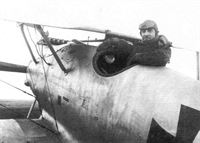 |
J.Herris - Pfalz Aircraft of WWI /Centennial Perspective/ (5) |
| Unknown pilot in his Pfalz D.III. |
 |
K.Delve - World War One in the Air /Crowood/ |
| The Pfalz DIII reached the Bavarian units at the front in the autumn of 1917. An Allied test on an aircraft captured the following February praised most aspects of this lighter. Pfalz DIII 1330/17. |
 |
J.Herris - Pfalz Aircraft of WWI /Centennial Perspective/ (5) |
| Pfalz D.III 1364/17. |
 |
J.Herris - Pfalz Aircraft of WWI /Centennial Perspective/ (5) |
| Pfalz D.III 1366/17 was photographed in front of the Adlershof hangars during the Typenprufung in May 1917. The black datum line on the nose was used to correctly align and rig the wing cellule. |
 |
J.Herris - Pfalz Aircraft of WWI /Centennial Perspective/ (5) |
| An early production Pfalz D.III 1366/17 painted in the standard factory finish of silver-gray. The aluminum powder in the paint protected the wood and fabric from the sun and provided 'air-superiority' style camouflage. "D.III 1366/17" appears above the rudder cross, and the Pfalz logo is on the rudder balance area. |
 |
J.Herris - Pfalz Aircraft of WWI /Centennial Perspective/ (5) |
| Pfalz D.III 1369/17 of Jasta 11. At least one Jasta 11 pilot is recorded as having flown a Pfalz D.IIIa; Lt. von Linsingen crashed D.IIIa 4223/17 on 24 January 1918 and was hospitalized. The white tail was a personal marking, supplemented by a dark fuselage band (red? black?). There are non-standard (for Pfalz) white borders on the fuselage cross and apparently on the under-wing crosses. |
 |
J.Herris - Pfalz Aircraft of WWI /Centennial Perspective/ (5) |
| Pfalz D.III lineup of Jasta 10 on Courtrai aerodrome, circa November 1917. Hecht's 1370/17 is third from right. The stripes on the fuselage and top wing of Hecht's D.III were black and the tail was green.The yellow noses and wheels, Jasta 10's unit markings, show up dark with the type of film used. |
 |
J.Herris - Pfalz Aircraft of WWI /Centennial Perspective/ (5) |
| Pfalz D.III 1370/17, wearing factory markings only, is newly arrived at Jasta 10. |
 |
J.Herris - Pfalz Aircraft of WWI /Centennial Perspective/ (5) |
| Downed 1370/17 is being transported back from the front after being downed by No.35 Sqdn., RFC near Villers-Carbonnel on 27 December 1917. |
 |
K.Delve - World War One in the Air /Crowood/ |
| Pfalz DIII 1370/17 (which acquired G 110 as its captured serial). The aircraft belonged to Jasta 10 and was shot down by a 35 Squadron aircraft on 27 December 1917. It is seen here at Estrees-aux-Chausee. |
 |
J.Herris - Pfalz Aircraft of WWI /Centennial Perspective/ (5) |
| Downed Pfalz D.III 1370/17 is re-assembled and in British hands (designated G.110) after being downed by No.35 Sqdn. The pilot was Vzfw. Hecht of Jasta 10. The supplementary wingtip bracing cable installed after the aircraft reached the front is barely visible. |
 |
Сайт - Pilots-and-planes /WWW/ |
| Pfalz D.III 1370/17. Capture number G.110 |
 |
Журнал - Flight за 1918 г. |
| Side view of the Pfalz single-seater fighter, 160 h.p. Mercedes engine. |
 |
J.Herris - Pfalz Aircraft of WWI /Centennial Perspective/ (5) |
| Pfalz D.III 1370/17 of Jasta 10 after capture with its German insignia painted over. |
 |
J.Herris - Pfalz Aircraft of WWI /Centennial Perspective/ (5) |
| More views of Pfalz D.III 1370/17 of Jasta 10 after capture with its German insignia painted over. |
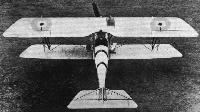 |
Журнал - Flight за 1918 г. |
| View from above of the Pfalz single-seater fighter, 160 h.p. Mercedes engine. |
 |
Jane's All The World Aircraft 1919 /Jane's/ |
| Rear view of the Pfalz Chaser, D.III type. |
 |
Журнал - Flight за 1918 г. |
| Front view of the Pfalz single-seater fighter, 160 h.p. Mercedes engine. |
 |
Jane's All The World Aircraft 1919 /Jane's/ |
| Front view of the Pfalz Single-seater D.III Type. |
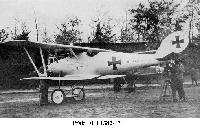 |
Сайт - Pilots-and-planes /WWW/ |
| Pfalz D.III 1382/17 |
 |
J.Herris - Pfalz Aircraft of WWI /Centennial Perspective/ (5) |
| Pfalz D.III 1386/17 of Jasta 22 flown by Lt. Alfred Lenz, CO. The markings on either side of the fuselage cross are black, as are the sloping bands on the horizontal tail and upper wing. |
 |
J.Herris - Pfalz Aircraft of WWI /Centennial Perspective/ (5) |
| Pfalz D.III 1395/17 was one of the few factory-camouflaged D.III fighters assigned to Jasta 10. At left Lt. Heldmann is sitting on the wheel; white or light blue wheels were apparently part of his personal markings. |
 |
J.Herris - Pfalz Aircraft of WWI /Centennial Perspective/ (5) |
| Heldmann is donning his flying clothes before a mission. Heldmann went on to fly a Fokker D.VII with Jasta 10. |
 |
J.Herris - Pfalz Aircraft of WWI /Centennial Perspective/ (5) |
| Another photo of factory-camouflaged Pfalz D.III 1395/17 of Jasta 10 and Lt. Heldmann getting ready to fly. Lt. Heldmann achieved 15 confirmed victories, all while serving with Jasta 10, and was twice acting commander during 1918. |
 |
J.Herris - Pfalz Aircraft of WWI /Centennial Perspective/ (5) |
| Oberleutnant Oskar Freiherr von Boenigk of Jasta 4 in his Pfalz D.III 1396/17. The machine gun muzzle is visible beside the engine. Below the stencil - Leergewicht 695 Kg (empty weight) and zulassige Belastung bei vollem Tank 170 Kg (permissible load with full tank) - are the rigging instructions and the small manufacturer's nameplate. In Jasta 4 von Boenigk scored 7 victories before he left to command Jasta 21. He achieved a total of 26 victories, eventually commanded JGII, and won the Pour le Merite. |
 |
J.Herris - Pfalz Aircraft of WWI /Centennial Perspective/ (5) |
| Pfalz D.III 1397/17 of Jasta 4. |
 |
J.Herris - Pfalz Aircraft of WWI /Centennial Perspective/ (5) |
| Pfalz D.III 1405/17 in service with Jasta 32b after unit and personal markings were applied. It was probably flown by Offz.Stv. Jakob Landin. The nose, tail, and "L" are black and the spinner is white over standard factory finish. |
 |
J.Herris - Pfalz Aircraft of WWI /Centennial Perspective/ (5) |
| Pfalz D.III 1405/17 displays its clean lines, access panels, and factory finish. This is Sanke Card No. 1053. First flown around June 1917, the clean-looking Pfalz D III, like its near contemporary, the Albatros DV, was to prove inferior to the Camel, SE 5 and Spad that were to be encountered in ever growing numbers from the summer of 1917 onwards. Initially deployed operationally in late August 1917, the 160hp Mercedes D III-powered machine lacked the agility and climb capability of the Albatros DV, but was faster than the D V, having a top level speed of 112mph at sea level, falling to 103mph at 9.840 feet. Further, the Pfalz D III was extremely robust and suffered none of the wing flutter problems of the Albatros series. It was therefore useful for fast attack missions such as those against well defended balloons. The one area that pilots were particularly critical of in the D III was that of climb, the D III taking 7 minutes to reach 5,000 feet, compared with the SE 5A's 5 minutes 35 seconds to reach the same height. Notwithstanding, the twin 7.92mm Spandau armed D III's career paralleled that of the Albatros DV in as much as it was to be produced in an up-rated D IIIa form towards the close of 1917. Based on the operational numbers on record for April 1918, the total Pfalz D III and IIIa build must have been around 1,000 machines. |
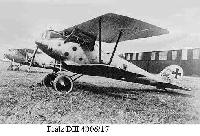 |
Сайт - Pilots-and-planes /WWW/ |
| Pfalz D.III 4006/17 |
 |
J.Herris - Pfalz Aircraft of WWI /Centennial Perspective/ (5) |
| Pfalz D.III 4011/17 of Jasta 21, flown by Lt. Fritz Hohn, winter of 1917-18. The machines of this unit also carried small personal numbers in black, in this case marked beneath the serial number on the fuselage. The combination of horizontal and diagonal stripes were an attempt to make the aircraft more difficult for ground gunners to hit, and were applied as Hohn was beginning his career as a balloon buster. |
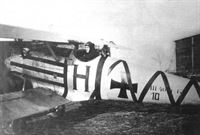 |
J.Herris - Pfalz Aircraft of WWI /Centennial Perspective/ (5) |
| Pfalz D.III 4011/17 of Lt. Fritz Hohn of Jasta 21, winter of 1917-1918, with his teddy bear mascot. |
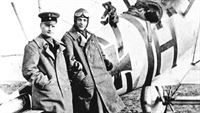 |
J.Herris - Pfalz Aircraft of WWI /Centennial Perspective/ (5) |
| Ltn. Fritz Hohn (right) of Jasta 21s and two friends (see teddy bear fastened to the rear cockpit decking) prepare for takeoff in Hohn’s elaborately marked Pfalz D.IIIa. German pilots were well known for applying lavish markings on their aircraft as well as having lucky talismans, and mascots, including monkeys, baboons, and nearly every breed of dog! |
 |
J.Herris - Pfalz Aircraft of WWI /Centennial Perspective/ (5) |
| Pfalz D.III 4011/17 of Lt. Fritz Hohn in Jasta 21, winter of 1917-1918, with his teddy bear mascot. This D.III wore the Jasta 21 unit marking of a vertical black and white line just aft of the cockpit. The top surface of the wings and the rest of the aircraft markings were Hohn's individual markings. Hohn scored 21 confirmed victories, including 10 balloons. He later became acting commander of Jasta 60, then commander of Jasta 41, where he scored three victories in three days, but was then killed in action. |
 |
J.Herris - Pfalz Aircraft of WWI /Centennial Perspective/ (5) |
| Lt. Emil Thuy of Jasta 28 in his Pfalz D.IIIa 4017/17. Thuy had an impressive career; after scoring 14 victories flying with Jasta 21, he was made Staffelfuhrer of Jasta 28, which he commanded until the end of the war. Thuy scored 35 victories and was awarded the Pour le Merite. |
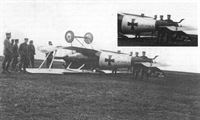 |
J.Herris - Pfalz Aircraft of WWI /Centennial Perspective/ (5) |
| Pfalz D.IIIa 4033/17 of Jasta 16b has experienced an all too common landing accident. |
 |
J.Herris - Pfalz Aircraft of WWI /Centennial Perspective/ (5) |
| Pfalz D.IIIa 4033/17 of Jasta 16b has experienced an all too common landing accident. |
 |
J.Herris - Pfalz Aircraft of WWI /Centennial Perspective/ (5) |
| Pfalz D.III 4034/17 of Uffz. Eugen Fortig of Jasta 16b crashed fatally during a familiarization flight on 27 January 1918. |
 |
Сайт - Pilots-and-planes /WWW/ |
| Fluglehrer Riensberg killed in the crash of Pfalz D.III 4049/17, Jan 13, 1917. |
 |
J.Herris - Pfalz Aircraft of WWI /Centennial Perspective/ (5) |
| Pfalz D.III 4056/17 of Jasta 16b. |
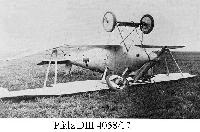 |
Сайт - Pilots-and-planes /WWW/ |
| Pfalz D.III 4058/17 |
 |
J.Herris - Pfalz Aircraft of WWI /Centennial Perspective/ (5) |
| Pfalz D.III 4059/17 of Lt. Heinrich Arntzen, Jasta 15, late 1917, at Le Clos Ferme (Boncours) airfield. Lt. Arntzen's personal emblem was a Prussian observer's badge (black and white quartering with a red border); no unit marking was in use at this time. Arntzen had a remarkable career; starting as a photographer in Zeppelins, he became an observer in aircraft, claiming four victories. He then became a pilot, first with Jasta 15 where he gained two more victories, then as CO of Jasta 50, where he brought his total to 11. During a balloon attack on 27 May, 1918 he was shot through the eye, yet survived. Despite the loss of an eye, he returned to combat flying single-seat photo-reconniassance missions. He kept the bullet removed from his brain and mounted it on a base as a momento! |
 |
J.Herris - Pfalz Aircraft of WWI /Centennial Perspective/ (5) |
| Uffz. Rudolf Ligenfelter poses with his Pfalz D.III 4062/17 of Jasta 16b. The black tail was the unit marking. Lingenfelter was killed in an accident on 21 February 1918 at Aertrycke airfield. |
 |
J.Herris - Pfalz Aircraft of WWI /Centennial Perspective/ (5) |
| Pfalz D.III 4063/17 of Jasta 21, taken at Jasta 21 and circulated around to nearby aviation units to familiarize them with the new type; the dark nose and tail were personal markings of the unknown pilot. |
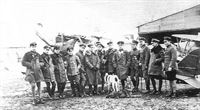 |
J.Herris - Pfalz Aircraft of WWI /Centennial Perspective/ (5) |
| Men of Jasta 21 posing with the same Pfalz. |
 |
J.Herris - Pfalz Aircraft of WWI /Centennial Perspective/ (5) |
| Pfalz D.III 4064/17 flown by Lt. Rudolf Stark of Jasta 34b. The wrinkled fuselage shows the effects of exposure to the elements that damaged the wooden shell. Lt. Stark scored five victories in Jasta 34b before moving to Jasta 77b as acting commander, where he scored one more victory. On 7 June 1918 he went to Jasta 35b as Staffelfuhrer, where he scored five more victories to bring his total to 11. The fuselage band and spinner on his Pfalz were painted lilac. |
 |
J.Herris - Pfalz Aircraft of WWI /Centennial Perspective/ (5) |
| Pfalz D.III 4102/17, unit unknown. |
 |
J.Herris - Pfalz Aircraft of WWI /Centennial Perspective/ (5) |
| Pfalz D.III 4114/17 eventually served with Kest 8; the wheels, nose, and tail are painted white. |
 |
J.Herris - Pfalz Aircraft of WWI /Centennial Perspective/ (5) |
| Pfalz D.III 4114/17 after a bad landing. The Kest 8 marking of a snake wrapped around the fuselage, not yet applied above, had been added before the accident. |
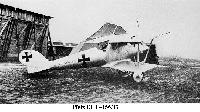 |
Сайт - Pilots-and-planes /WWW/ |
| Pfalz D.III 4156/17 |
 |
J.Herris - Pfalz Aircraft of WWI /Centennial Perspective/ (5) |
| Vzfw. Hitschler of Jasta 18 is photographed with a hybrid Pfalz D.IIIa that could be 4165/17, the prototype. This aircraft has the rounded tailplane and raised guns of the D.IIIa but retains the pointed lower wings of the D.III. The bracing cables to the upper wingtips are barely visible in the original photograph. |
 |
J.Herris - Pfalz Aircraft of WWI /Centennial Perspective/ (5) |
| Cockpit of the Pfalz D.IIIa prototype, 4165/17, clearly shows the raised machine guns that were much more accessible to the pilots in case of a jam The tachometer is the round instrument in the center of the panel. |
 |
J.Herris - Pfalz Aircraft of WWI /Centennial Perspective/ (5) |
| Pfalz D.III 4169/17 of Marine Feld Jasta II crashed by Flugmaat Undiener, who was killed. |
 |
J.Herris - Pfalz Aircraft of WWI /Centennial Perspective/ (5) |
| Pfalz D.III 4184/17 of Jasta 15 flown by Uffz. Hegeler is shown here after capture. Hegeler was downed by Lt. A. Cowper of No.24 Sqdn., RFC, on 26 Feb. 1918. The marking behind the cockpit is black with the basic silver color showing through the ovals. Allocated the British capture number G.141, it was subsequently displayed in London's Agricultural Hall. |
 |
O.Thetford, P.Gray - German Aircraft of the First World War /Putnam/ |
| Hegeler's Pfalz D III (serial 4184/17). Capture number G.141 |
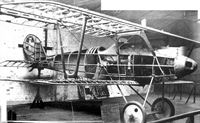 |
J.Herris - Pfalz Aircraft of WWI /Centennial Perspective/ (5) |
| На фотографии изображен Пфальц DIII, у которого снята вся обшивка, за исключением алюминиевой. Captured Pfalz D.III 4184/17 stripped bare for inspection. The light fuselage framework supported an outer plywood shell, created by the Wickelrumpf technique. The barrel of one of the buried machine guns is just visible. |
 |
J.Herris - Roland Aircraft of WWI /Centennial Perspective/ (9) |
| Captured Pfalz D.III 4184/17 stripped bare for inspection. The light fuselage framework supported an outer plywood shell, created by the Wickelrumpf technique. |
 |
Сайт - Pilots-and-planes /WWW/ |
| Cockpit of Pfalz D.III 4184/17 of Jasta 15 captured on February 26, 1918 and assigned the British captured aircraft number G.141 |
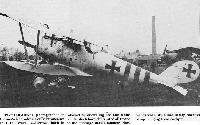 |
Сайт - Pilots-and-planes /WWW/ |
| Pfalz D.III 4185/17 photographed at the Jasta 5 aerodrome at Boistrancourt in 1917. Overall silbergrau finish is relieved by encircling red and white bands which have obliterated all traces of the fuselage serial number. Note windscreen style and safety harness Strap hanging from cockpit. |
 |
J.Herris - Pfalz Aircraft of WWI /Centennial Perspective/ (5) |
| Pfalz D.IIIa prototype. |
 |
J.Herris - Pfalz Aircraft of WWI /Centennial Perspective/ (5) |
| Pfalz D.IIIa 4202/17 of Jasta 30 with pilots: left to right: Lt.d.R. Hans Holthausen, Oblt. Hans Bethge (with glasses), Lt. Karl Weitz, and Lt. Freiherr von der Horst. |
 |
J.Herris - Pfalz Aircraft of WWI /Centennial Perspective/ (5) |
| Pfalz D.IIIa 4203/17 of Jasta 30, flown by Staffelfuhrer Lt. Hans-Georg von der Marwitz. |
 |
J.Herris - Pfalz Aircraft of WWI /Centennial Perspective/ (5) |
| D.IIIa 4203/17 of a Marine Feld Jasta. |
 |
J.Herris - Pfalz Aircraft of WWI /Centennial Perspective/ (5) |
| Flugmaat Undiener, probably with Marine Feld Jasta II, with Pfalz D.IIIa 4215/17. A Pfalz logo is on the cabane strut; the fuel lines from the upper wing show clearly. |
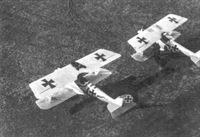 |
J.Herris - Pfalz Aircraft of WWI /Centennial Perspective/ (5) |
| Two Pfalz D.IIIa fighters of Kest 8, with Pfalz D.IIIa 4229/17 at left with the snake marking around the fuselage. |
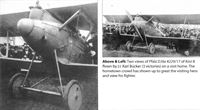 |
J.Herris - Pfalz Aircraft of WWI /Centennial Perspective/ (5) |
| Two views of Pfalz D.IIIa 4229/17 of Kest 8 flown by Lt. Karl Bucker (3 victories) on a visit home. The hometown crowd has shown up to great the visiting hero and view his fighter. |
 |
J.Herris - Pfalz Aircraft of WWI /Centennial Perspective/ (5) |
| Lt. Karl Bucker at left with his Pfalz D.IIIa 4229/17 of Kest 8 during his visit home. |
 |
J.Herris - Pfalz Aircraft of WWI /Centennial Perspective/ (5) |
| Pfalz D.IIIa 4229/17 wearing the Kest 8 marking wrapped around the fuselage has some pilots on it. From left to right, Lt.d.R. Wilhelm Neuenhofen (15 victories), Off.- Stv. Hilger, Lt. Karl Bucker (3 victories), and Vzfw. Bohlen. |
 |
В.Кондратьев - Самолеты первой мировой войны |
| "Пфальц" D.IIIa с "тевтонским" крестом. |
 |
J.Herris - Pfalz Aircraft of WWI /Centennial Perspective/ (5) |
| Lt. Rudolf Stark poses by Pfalz D.IIIa 5882/17, one he flew in Jasta 34b. Stark's lilac fuselage band is visible. |
 |
J.Herris - Pfalz Aircraft of WWI /Centennial Perspective/ (5) |
| Ltn.d.R. Emil Koch, commander of Jasta 32b, poses with Pfalz D.IIIa 5885/17 of the unit, circa May 1918. |
 |
J.Herris - Pfalz Aircraft of WWI /Centennial Perspective/ (5) |
| Hptm. Franz Hailer in Pfalz D.IIIa 5895/17. The dark painted fuselage wears a band of blue and white Bavarian diamonds, reflecting Hailer's Bavarian origin. |
 |
J.Herris - Pfalz Aircraft of WWI /Centennial Perspective/ (5) |
| Marine Lt. Carl Kuring of Marine Feld Jasta III in his Pfalz D.IIIa 5940/17. |
 |
J.Herris - Pfalz Aircraft of WWI /Centennial Perspective/ (5) |
| Pfalz D.IIIa 5947/17 of Jasta 30, flown by Lt. Freiherr von der Horst. |
 |
Сайт - Pilots-and-planes /WWW/ |
| Pfalz D.IIIa 5947/17 of Jasta 30 with ground crew. |
 |
J.Herris - Pfalz Aircraft of WWI /Centennial Perspective/ (5) |
| Lt. Erich Kaus and ground crew with Pfalz D.IIIa 5981/17 of Jasta 30. |
 |
J.Herris - Pfalz Aircraft of WWI /Centennial Perspective/ (5) |
| The third pilot to be awarded the Pour le Merite was Oblt. Hans-Joachim Buddecke. He is shown in his Pfalz D.IIIa 5983/17 during the brief time he flew with Jasta 30 in 1918. Buddecke won most of his fame in Turkey, raising his score to 13 confirmed victories. When he returned to the Western Front air combat had changed greatly, and he was killed in action with Sopwith Camels of No.3 Squadron, RNAS, on March 10,1918, before he could adjust to the new conditions. He was killed going to the aid of his old friend Rudolf Berthold, himself a Pour le Merite ace who scored 44 victories. |
 |
J.Herris - Pfalz Aircraft of WWI /Centennial Perspective/ (5) |
| Pfalz D.IIIa 6014/17 in late-war insignia with camouflage fabric covering the wings.This Pfalz belonged to Grenschutz Allenstein, a post-war border defense unit made up of both fighters and two-seaters. |
 |
H.Cowin - Aviation Pioneers /Osprey/ |
| Pfalz D IIIa, serial 6014/17, photographed sometime after 15 April 1918, as indicated by the machine's Balkankreuse markings. Although the Pfalz fighter equipped a large number of Jastas, it seems it never equipped any one exclusively. |
 |
J.Herris - Pfalz Aircraft of WWI /Centennial Perspective/ (5) |
| Grenzschutz Allenstein, a post-war border-defense unit, has a collection of fighters and two-seaters including, second from left, Pfalz D.IIIa 6014/17. |
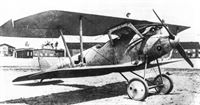 |
J.Herris - Pfalz Aircraft of WWI /Centennial Perspective/ (5) |
| Pfalz D.IIIa 6033/17. |
 |
J.Herris - Pfalz Aircraft of WWI /Centennial Perspective/ (5) |
| Lt. Fritz Hohn flew similarly-marked Pfalz D.IIIa 8009/17 while still with Jasta 21. Hohn is at right, again with his teddy bear mascot. Lt. Muller of Flieger-Abteilung (A) 274 is at left. |
 |
J.Herris - Pfalz Aircraft of WWI /Centennial Perspective/ (5) |
| Pfalz D.IIIa 8033/17 of Jasta 64w. |
 |
J.Herris - Pfalz Aircraft of WWI /Centennial Perspective/ (5) |
| Pfalz D.IIIa 8033/17 in French hands. |
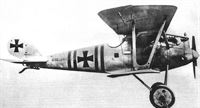 |
J.Herris - Pfalz Aircraft of WWI /Centennial Perspective/ (5) |
| Pfalz D.IIIa 8033/17 after capture. |
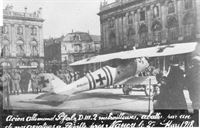 |
J.Herris - Pfalz Aircraft of WWI /Centennial Perspective/ (5) |
| Pfalz D.IIIa 8033/17 of Jasta 64w after capture. The pilot, Offz.-Stv. Schuschke, was made POW on 27 March, 1918. In the above image the aircraft was on display at Nancy. The work no. was 1663. |
 |
J.Herris - Pfalz Aircraft of WWI /Centennial Perspective/ (5) |
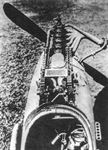 |
J.Herris - Pfalz Aircraft of WWI /Centennial Perspective/ (5) |
| The cockpit, engine, and machine guns of Pfalz D.IIIa 8033/17 show a key difference from the D.III with its buried machine guns. A flare cartridge rack is on the right side of the fuselage next to the cockpit. |
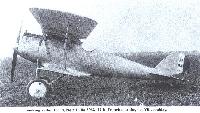 |
Сайт - Pilots-and-planes /WWW/ |
| Looking rather bland, Pfalz D.IIIa 8033/17 in French markings at Villacoublay. |
 |
J.Herris - Pfalz Aircraft of WWI /Centennial Perspective/ (5) |
| Pfalz D.IIIa 8052/17 of Lt. Moch with '10' on the fuselage, under the starboard lower wing, and perhaps the top of the upper wing; unit unknown. |
 |
J.Herris - Pfalz Aircraft of WWI /Centennial Perspective/ (5) |
| Pfalz D.IIIa, probably 8131/17, and other captured German aircraft on display in London during the war. |
 |
J.Herris - Pfalz Aircraft of WWI /Centennial Perspective/ (5) |
| "Пфальц" D.IIIa с "балканским" крестом. Pfalz D.IIIa 8143/17 with modified tailplane with its original iron crosses over-painted in accordance with the Kogenluft (Kommandierenden General der Luftstreitkrafte - Commanding General Air Services) instructions issued 17 March 1918 before Operation Michael, the German spring offensive designed to win the war before American troops could reach the front in numbers. The upper fuselage and wings have been over-painted, but the colors and unit are unknown. |
 |
J.Herris - Pfalz Aircraft of WWI /Centennial Perspective/ (5) |
| Pfalz D.IIIa 8170/17 of Lt. Hans Bohning, Jasta 79b, with five-color camouflage fabric on lower wing and Bohning's "HB" initial. Bohning scored 17 confirmed victories, the last 12 in Jasta 79b. He survived the war. |
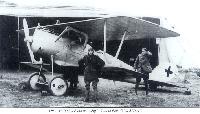 |
Сайт - Pilots-and-planes /WWW/ |
| Ltn.d.R. Rudolf Stark standing in front of Pfalz D.IIIa 8178/17. |
 |
J.Herris - Pfalz Aircraft of WWI /Centennial Perspective/ (5) |
| Lt. Rudolf Stark of Jasta 34b preparing for take-off in Pfalz D.IIIa 8178/17 in early 1918. The fuselage band and spinner on his Pfalz were painted lilac. Stark later flew a Fokker Triplane with lilac engine cowling and fuselage band, and finished the war flying a Fokker D.VII with lilac fuselage band and cowling in Jasta 35b. |
 |
J.Herris - Pfalz Aircraft of WWI /Centennial Perspective/ (5) |
| Pfalz D.IIIa 8190/17 in factory finish with a dark band around the fuselage. |
 |
J.Herris - Pfalz Aircraft of WWI /Centennial Perspective/ (5) |
| Pfalz D.IIIa, probably 8282/17, of Flieger Andreas Kohler of Jasta 35 brought down by ground fire on 24 April 1918. The photos were taken at No.2 Aircraft Depot at Candas on 26 April 1918. |
 |
J.Herris - Pfalz Aircraft of WWI /Centennial Perspective/ (5) |
| Pfalz D.IIIa 8284/17 of Jasta 77b flown by Vzfw. Jacob Pollinger is shown before capture. |
 |
J.Herris - Pfalz Aircraft of WWI /Centennial Perspective/ (5) |
| Pollinger's Pfalz D.IIIa 8284/17 of Jasta 77b being removed from the front after capture. |
 |
J.Herris - Pfalz Aircraft of WWI /Centennial Perspective/ (5) |
| Pfalz D.IIIa 8284/17 of Jasta 77b flown by Vzfw. Jacob Pollinger is shown after capture with crosses over-painted. Pollinger ran out of fuel and came down behind British lines on 30 May 1918. A novice, he had joined Jasta 77b from Jastaschule I on 22 May 1918. The swastika, a Nordic symbol for good luck, was his personal insignia. |
 |
J.Herris - Pfalz Aircraft of WWI /Centennial Perspective/ (5) |
 |
J.Herris - Pfalz Aircraft of WWI /Centennial Perspective/ (5) |
| Pfalz D.IIIa 1296/18 of Jasta 56 with a Jasta 56 Fokker D.VII in the background. Both aircraft carry the unit markings of chrome yellow nose and tail with blue-gray fuselage. |
 |
J.Herris - Pfalz Aircraft of WWI /Centennial Perspective/ (5) |
| Pfalz D.IIIa 1306/17 with Mercedes D.III Nr. 37554 force-landed in the Netherlands on June 11 or 12, 1918. It was flown by Gefr. Heinz Kleineberg of Jasta 20. |
 |
J.Herris - Pfalz Aircraft of WWI /Centennial Perspective/ (5) |
| Pfalz D.IIIa. |
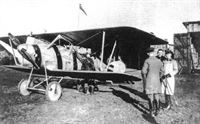 |
J.Herris - Pfalz Aircraft of WWI /Centennial Perspective/ (5) |
| Pfalz D.IIIa 42xx/17 of Jasta 4. The black stripes on the fin and underside of the tailplane are personal markings. |
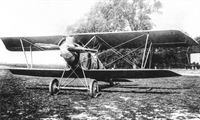 |
J.Herris - Pfalz Aircraft of WWI /Centennial Perspective/ (5) |
| Pfalz D.III of Jasta 4. The black spiral ribbon around the fuselage was the Jasta 4 unit marking. |
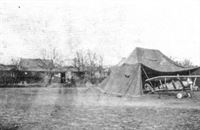 |
J.Herris - Pfalz Aircraft of WWI /Centennial Perspective/ (5) |
| Pfalz D.IIIa of Jasta 4, Flugplatz Awoingt, March 1918. The Pfalz displays the spiral band Jasta 4 marking and painted tail (and spinner?) as personal markings. |
 |
J.Herris - Pfalz Aircraft of WWI /Centennial Perspective/ (5) |
| Lt. Karl Meyer, Jasta 4, by the tail of a Pfalz D.IIIa that may have been his with a personal marking of dark tail and spinner. There appears to be a darker stripe on the tailplane and elevators. Meyer scored four confirmed victories. Flugplatz Awoingt, circa March 1918. |
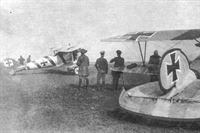 |
J.Herris - Pfalz Aircraft of WWI /Centennial Perspective/ (5) |
| Pfalz D.IIIa of Jasta 4 with an Albatros D.Va of Jasta 4 at right. |
 |
J.Herris - Pfalz Aircraft of WWI /Centennial Perspective/ (5) |
| Left, Lt. Johann Janzen, Jasta 6, 13 victories and right, Lt. Viktor von Pressentin (genannt von Rautter) with two Pfalz D.IIIa fighters of Jasta 4 at Lechelle, April 1918. The Pfalz at left is silver-gray; that on the right has printed five-color camouflage fabric on the wings. |
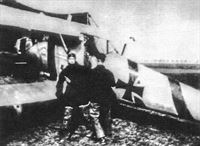 |
J.Herris - Pfalz Aircraft of WWI /Centennial Perspective/ (5) |
| Pfalz D.III of Jasta 4 with unknown pilot. |
 |
J.Herris - Pfalz Aircraft of WWI /Centennial Perspective/ (5) |
| Pfalz D.IIIa of Jasta 4 with Lt. Raven Freiherr von Barnekow being assisted out of his RFC-style flying boots. Another Jasta 4 Pfalz D.IIIa is in the background. Barnekow scored no victories in Jasta 4 but went on to score 11 confirmed victories while serving with Jasta 20 and Jasta 1 and survived the war. |
 |
J.Herris - Pfalz Aircraft of WWI /Centennial Perspective/ (5) |
| Pfalz D.III of Jasta 4 taking off. |
 |
J.Herris - Pfalz Aircraft of WWI /Centennial Perspective/ (5) |
| Pfalz D.IIIa fighters of Jasta 4 at Lechelle. |
 |
J.Herris - Pfalz Aircraft of WWI /Centennial Perspective/ (5) |
| Pfalz D.III fighters of Jasta 4 at Armee Flugpark 4 with their distinctive black spiral ribbon unit markings. |
 |
J.Herris - Pfalz Aircraft of WWI /Centennial Perspective/ (5) |
| Jasta 7 lineup with Lt. Carl Degelow's Pfalz D.IIIa at far right. |
 |
J.Herris - Pfalz Aircraft of WWI /Centennial Perspective/ (5) |
| Degelow's Pfalz after a landing accident. Josef Jacob's diary for 23 March 1918 read: "Upon landing, Lt. Degelow raced against a 30 kph headwind; machine turned over." |
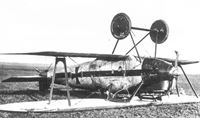 |
J.Herris - Pfalz Aircraft of WWI /Centennial Perspective/ (5) |
| The Pfalz D.III of Lt. Hans Klein of Jasta 10 after a bad landing. Klein scored 22 victories and was awarded the Pour le Merits; he also survived the war. |
 |
J.Herris - Pfalz Aircraft of WWI /Centennial Perspective/ (5) |
| Lt. Hans Klein of Jasta 10 at left by his Pfalz D.III with Schwartzenberger in the cockpit. The black fuselage stripe was Klein's personal marking. |
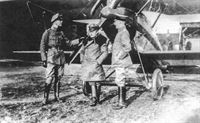 |
J.Herris - Pfalz Aircraft of WWI /Centennial Perspective/ (5) |
| Pfalz D.III of Jasta 10 with Schwarzenberger, Klein, and unknown. |
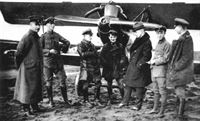 |
J.Herris - Pfalz Aircraft of WWI /Centennial Perspective/ (5) |
| Pfalz D.III of Jasta 10 during a visit by Ernst Eversbusch, one of the Pfalz company founders. From left are: Unknown, Hptm. Kurt Schwarzenberger of Idflieg, Lt. Hans Klein, Lt. Kuhn, Ernst Eversbusch, Lt. Heldmann, and an unknown airman.The dark (black?) bands on the upper wing may have been formation leader's markings. |
 |
J.Herris - Pfalz Aircraft of WWI /Centennial Perspective/ (5) |
| Vzfw. Kurt Delang and a yellow-nosed Jasta 10 Pfalz D.IIIa with Axial propeller. Delang scored three victories and survived the war; he lived until 1983. |
 |
J.Herris - Pfalz Aircraft of WWI /Centennial Perspective/ (5) |
| Pfalz D.III of Jasta 10 and Lt. Friedrich "Fritz" Friedrichs in the cockpit. Lt. Friedrichs scored 21 confirmed victories and was nominated for the Pour le Merite, but he died when the ammunition in his Fokker D.VII ignited in flight and he did not receive the Pour le Merite. |
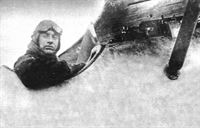 |
J.Herris - Pfalz Aircraft of WWI /Centennial Perspective/ (5) |
| Lt. Justus Grassmann in his Pfalz D.IIIa of Jasta 10. Lt. Grassmann scored 10 confirmed victories and survived the war. |
 |
J.Herris - Pfalz Aircraft of WWI /Centennial Perspective/ (5) |
| Vzfw. Friedrich Rudenberg was one of two Jasta 10 pilots that accompanied Lt. Werner Voss on his final flight in his Fokker F.I 103/17 triplane. |
 |
J.Herris - Pfalz Aircraft of WWI /Centennial Perspective/ (5) |
| Vzfw. Friedrich Rudenberg of Jasta 10 in his Pfalz D.III; other Pfalz D.III fighters of Jasta 10 are in the background. |
 |
J.Herris - Pfalz Aircraft of WWI /Centennial Perspective/ (5) |
| Pfalz D.III of Jasta 10 said to belong to Lt. Werner Voss. |
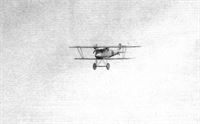 |
J.Herris - Pfalz Aircraft of WWI /Centennial Perspective/ (5) |
| Lt. Werner Voss flying his Pfalz D.III. |
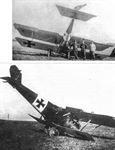 |
J.Herris - Pfalz Aircraft of WWI /Centennial Perspective/ (5) |
| At least two early production Pfalz D.III fighters with factory camouflage were assigned to Jasta 10. In addition to Lt. Heldmann's 1395/17, this one was crashed by Lt. Gustav Bellen on 11 September 1917. The camouflage was green and mauve on the upper surfaces with undersurfaces in silver-gray. On this aircraft a white band circled the fuselage; the fuselage national insignia were apparently outlined in silver-gray. A flare pistol and cartridge rack are mounted on the right side of the cockpit. Bellen downed a balloon on 21 Sept. 1917 for his only victory. He was one of the pilots who flew with Lt. Voss on his fatal flight. |
 |
J.Herris - Pfalz Aircraft of WWI /Centennial Perspective/ (5) |
| Lt Werner Voss second from left with his brothers Max at far right and Otto second from right and Idflieg officers at far left and center. A new Pfalz D.III is in the hangar behind them. (Courtesy Lance Bronnenkant) |
 |
J.Herris, T.Phillips - Fokker Aircraft of WWI. Vol.4: V.1-V.8, F.I & Dr.I /Centennial Perspective/ (54) |
| One of four views of F.I 103/17 as it appeared during the visit to Jasta 10 made by Karl Albrecht, Archduke of Austria-Teschen, on 9 September 1917. The Archduke and Voss discuss something. Voss's Pfalz D.III fighter and other Jasta 10 Pfalz D.III fighters are behind them. |
 |
J.Herris, T.Phillips - Fokker Aircraft of WWI. Vol.4: V.1-V.8, F.I & Dr.I /Centennial Perspective/ (54) |
| One of four views of F.I 103/17 as it appeared during the visit to Jasta 10 made by Karl Albrecht, Archduke of Austria-Teschen, on 9 September 1917. Voss'ground crewmen work on 103/17. Voss' trusted mechanics Flieger Karl Timm and Gefreiter Rueser prepare F.I 103/17 for a demonstration flight during the Austrian Crown Prince's visit to Marckebeeke. Voss is already in the cockpit in this beautiful, roughly noon-time photograph. The reflectivity of the light blue paint on the wing undersurfaces is readily apparent. This view confirms all struts, including the landing gear struts, were in matching light blue paint. The lack of castor oil stains on the white cowl face and shadows thrown by the Triplane confirm this photo was taken after the inspection and before the demonstration flight. The strut brace for the horizontal stabilizer is visible in this photo. Werknummer 1730 is again visible on the inside of the upper port interplane strut. With a mechanic ready to swing the propeller and two more in attendance, this Fokker Dr I pilot prepares for take-off. Alongside the Dr I is a Pfalz D III of the same Jasta helping illustrate the mixture of types that remained characteristic of German front-line Jastas all the way through to the Armistice. In contrast, the British and French had long since realised the logistical, maintenance and operational benefits of standardising aircraft and engines at squadron level. |
 |
J.Herris, T.Phillips - Fokker Aircraft of WWI. Vol.4: V.1-V.8, F.I & Dr.I /Centennial Perspective/ (54) |
| The high gloss paint of F.I 103/17 is plainly visible in this mid-morning photograph. Crown Prince Otto von Hapsburg inspects Jasta 10 and its aircraft.The small number of personnel gives some idea of how small a German Jagdstaffel was compared to British or US squadrons. F.I 103/17 again sits to the right of Jasta 10's Pfalz D.IIIs. Voss stands with his back to the camera, facing the Crown Prince. On the left of the photograph, Oberleutnant Kurt-Bertram von Doring, Rittmeister von Richthofen's second in command at Jagdgeschwader I, has found something more amusing to watch. Von Doring, an ace with 11 eventual victories, was promoted to Rittmeister while at JG I and assumed command of Jagdgruppe 4 on 6 February 1918. Oberleutnant Bodenschatz, second from left, looks on dispassionately, while von Richthofen, hat pulled low to cover bandages from his 6 July 1917 head wound, and most of Jasta 10 salute. |
 |
J.Herris - Pfalz Aircraft of WWI /Centennial Perspective/ (5) |
| Pfalz D.IIIa and Albatros fighters line up at Flugplatz Awoingt, March 1918. Jasta 10 is in the foreground and Jasta 4 is in the background. |
 |
J.Herris - Pfalz Aircraft of WWI /Centennial Perspective/ (5) |
| Jasta 15 lineup with a mixture of Pfalz D.III and Albatros D.V aircraft.This is a significantly earlier view of Jasta 15, before Rudolf Bertold took command, possibly January 1918. "N" is the Pfalz D.III of Lt. Claus von Waldow. The Albatros D.V with the skull marking was apparently flown by Lt. Karl Albert. |
 |
J.Herris - Pfalz Aircraft of WWI /Centennial Perspective/ (5) |
| Jagdgeschwader II, Jasta 15 lineup in April 1918 at Balatre.The first aircraft is the Pfalz D.IIIa of Hptm. Rudolf Berthold, CO of JGII. |
 |
J.Herris - Pfalz Aircraft of WWI /Centennial Perspective/ (5) |
| Pfalz D.IIIa fighters of Jasta 16b; all have black spinners. |
 |
J.Herris - Pfalz Aircraft of WWI /Centennial Perspective/ (5) |
| Pfalz D.IIIa of Jasta 16b flown by Oblt. Friedrich "Fritz" Roth. Von Roth achieved a total of 28 confirmed victories, of which 20 were balloons; he was the highest-scoring German pilot against these dangerous targets. On 24 April 1918 he became CO of Jasta 16b, and on 29 May 1918 he shot down five balloons in one mission. On 9 September 1918 he was awarded the Pour le Merits.The white/black/white stripe is painted to the rear on the aircraft's other side. |
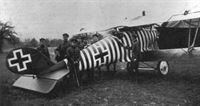 |
J.Herris - Pfalz Aircraft of WWI /Centennial Perspective/ (5) |
| A spectacularly-marked Pfalz D.IIIa, probably from Jasta 16b. The men are from Flieger Abteilung(A) 212. |
 |
J.Herris - Pfalz Aircraft of WWI /Centennial Perspective/ (5) |
| This spectacularly marked Pfalz D.IIIa was flown by Vzfw. Josef Schaefer of Jasta 16b. The black rings around the fuselage and black tail appear common on Jasta 16b Pfalz fighters; the unit marking was the black tail. |
 |
J.Herris - Pfalz Aircraft of WWI /Centennial Perspective/ (5) |
| One of the most spectacularly marked Pfalz D.IIIa fighters was this aircraft of Jasta 16b flown by Vzfw. Max Holtzem, who had previously been an acceptance test pilot at Pfalz.The exhaust pipes have been shortened and a signal flare cartridge rack has been fitted. A star emblem is on the upper left wing. |
 |
J.Herris - Pfalz Aircraft of WWI /Centennial Perspective/ (5) |
| Dark colored Pfalz D.IIIa fighters of Jasta 18. The man-in-the-moon emblem is that of Hans Burkhard von Buttlar. |
 |
J.Herris - Pfalz Aircraft of WWI /Centennial Perspective/ (5) |
| Photos of a Pfalz D.III of Jasta 18 flown by Lt. Hans-Burkard von Buttlar. |
 |
J.Herris - Pfalz Aircraft of WWI /Centennial Perspective/ (5) |
| Pfalz D.IIIa of Jasta 18 flown by Lt. Hans von Buttlar. This aircraft had previously been flown by Gefr. Hitschler; after it was assigned to von Buttlar he had the five white stripes painted over and added his hunting horn emblem. Above left a mechanic is in the cockpit; below von Buttlar is in the cockpit. |
 |
H.Cowin - Aviation Pioneers /Osprey/ |
| This initial production batch Pfalz D III of Lt Lenz, Jasta 22 was delivered in August 1917, when the unit was based at Vivaise. |
 |
J.Herris - Pfalz Aircraft of WWI /Centennial Perspective/ (5) |
| Pfalz D.III of Jasta 22 flown by Lt.d.R. Alfred Wunsch, whose personal markings of double black chevrons fore and aft of the fuselage cross are visible. |
 |
J.Herris - Pfalz Aircraft of WWI /Centennial Perspective/ (5) |
| Pfalz D.III of Jasta 22. This unidentified fighter has a dark fuselage with a diamond-shaped silver-gray background surrounding the fuselage cross. |
 |
J.Herris - Roland Aircraft of WWI /Centennial Perspective/ (9) |
| This Jasta 23b lineup is mostly Roland D.VIa fighters but includes at least two Pfalz D.IIIa fighters. |
 |
J.Herris, J.Leckscheid - Fokker Aircraft of WWI. Vol.5: 1918 Designs Part 2: D.VII & E.V/D.VIII /Centennial Perspective/ (55) |
| Six early-production Albatros-built D.VIIs head this small lineup of Jasta 40 at their airfield near Lomme in the early summer of 1918. Closest to the camera is the personal aircraft of the Staffelfuhrer, Lt. Carl Degelow. Besides his "white stag" fuselage marking, an oblique white bar has been painted on the center section of the top wing to denote his position as unit commander. Second in line is the heart-marked aircraft of Lt. Rosenstein, carrying a lengthwise white stripe on the upper wing, indicating his status as deputy leader. This was an earlier aircraft than the one seen in side view a few pages earlier. A Pfalz D.IIIa and an Albatros D.Va are obliged to hide at the end of the lineup. (Peter M. Grosz Collection/STDB) |
 |
J.Herris - Pfalz Aircraft of WWI /Centennial Perspective/ (5) |
| Pfalz D.IIIa of Jasta 30 with the CO, Lt. Hans-Georg von der Marwitz, with a relieved British POW of No. 208 Sqdn., Cowan, at left, who was flying Sopwith Camel D.9540. |
 |
J.Herris - Pfalz Aircraft of WWI /Centennial Perspective/ (5) |
| Pfalz D.IIIa of Jasta 30, with pilot Ltd.R. Kurt Katzenstein in the cockpit and unidentified ground crewmen. The Jasta 30 orange diamond is repeated on the top of the upper wing and the fuselage is over-painted (black?). Katzenstein scored one victory, a Sopwith Camel on 9 June 1918, possibly D3348 flown by Lt. W. Breckinbridge of No. 210 Squadron, RAF. |
 |
J.Herris - Pfalz Aircraft of WWI /Centennial Perspective/ (5) |
| Two views of the Pfalz D.IIIa with mouse-gray (not black) fuselage stripes previously flown by then Staffelfuhrer Oblt. Hans Bethge of Jasta 30. By the time these photos were taken the aircraft was being flown by Lt. Erich Kaus. Bethge scored 20 victories and was nominated for the Pour le Merite, but before it could be approved he was killed in action with a British two-seater while flying Pfalz D.IIIa 5888/17. According to Prussian custom, awards were not made posthumously because they were considered to be for the man, not his family or friends, and Bethge's Pour le Merite was not approved. |
 |
J.Herris - Pfalz Aircraft of WWI /Centennial Perspective/ (5) |
| Pfalz D.IIIa probably of Jasta 30. |
 |
J.Herris - Pfalz Aircraft of WWI /Centennial Perspective/ (5) |
| Pfalz D.IIIa fighters of Jasta 30 lined up at Phalempin. |
 |
J.Herris - Pfalz Aircraft of WWI /Centennial Perspective/ (5) |
| Pfalz D.IIIa lineup of Jasta 30 at Flugplatz Phalempin.The DFW C.V hack has Jasta 30's orange diamond marking. |
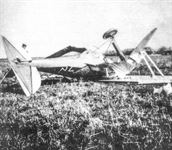 |
J.Herris - Pfalz Aircraft of WWI /Centennial Perspective/ (5) |
| Crashed Pfalz D.IIIa of Jasta 30 displays the Jasta's orange diamond under the tail surfaces. |
 |
J.Herris - Pfalz Aircraft of WWI /Centennial Perspective/ (5) |
| Pfalz D.IIIa fighters of Jasta 34b. |
 |
J.Herris - DFW Aircraft of WWI /Centennial Perspective/ (29) |
| Lt. Rudolf Stark, shown here with Pfalz fighters he flew in Jasta 34b, ended the war as Staffelfuhrer of Jasta 35b with 11 victories. Postwar he wrote the well-known book Wings of War, published in 1933, based on his wartime experiences. The Fokker D.VII in the USAF Museum carries the markings of the D.VII Stark flew when in command of Jasta 35b. The fuselage stripe was in lilac, as was the spinner. |
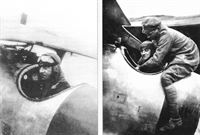 |
J.Herris - Pfalz Aircraft of WWI /Centennial Perspective/ (5) |
 |
J.Herris - Pfalz Aircraft of WWI /Centennial Perspective/ (5) |
| Pfalz D.IIIa formerly of Jasta 37. The above rearview of the Pfalz D.IIIa illustrates its streamlining, the rounded lower wingtips, and wide-chord tailplane characteristic of the D.IIIa. |
 |
J.Herris - Pfalz Aircraft of WWI /Centennial Perspective/ (5) |
| Pfalz D.IIIa formerly of Jasta 37, then a Jastaschule, photographed at Koblenz in 1919. The number "23" on the fuselage and under the wing was applied at the Jastaschule.The black and white tailplane stripes are part of Jasta 37's unit markings.This training aircraft has no spinner. This aircraft was turned over to the Americans in accordance with the armistice stipulations. |
 |
J.Herris - Pfalz Aircraft of WWI /Centennial Perspective/ (5) |
| Uffz. Hertel inside his Pfalz D.IIIa of Jasta 40. |
 |
J.Herris - Pfalz Aircraft of WWI /Centennial Perspective/ (5) |
| Uffz. Hertel beside his Pfalz D.IIIa of Jasta 40 after his personal dagger marking was added to the fuselage. |
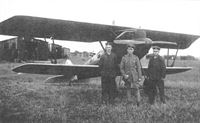 |
J.Herris - Pfalz Aircraft of WWI /Centennial Perspective/ (5) |
| Uffz. Hertel and his ground crew before his Pfalz D.IIIa of Jasta 40 after his personal dagger marking was applied |
 |
J.Herris - Pfalz Aircraft of WWI /Centennial Perspective/ (5) |
| Pfalz D.IIIa of Jasta 58 in basic silver with five-color camouflage fabric on wings and elevators. Nose and rudder are white. |
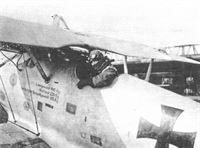 |
J.Herris - Pfalz Aircraft of WWI /Centennial Perspective/ (5) |
| Pfalz D.IIIa of Jasta 61. |
 |
J.Herris - Pfalz Aircraft of WWI /Centennial Perspective/ (5) |
| Pfalz D.IIIa of Jasta 62 flown by Vzfw. Karl Gerster. According to French intelligence reports, the Jasta 62 unit markings were the black fuselage with red engine cowling, which seems to fit this photo. The spinner and metal panels around the engine were red, with the rest of the fuselage black. |
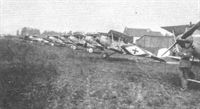 |
J.Herris - Pfalz Aircraft of WWI /Centennial Perspective/ (5) |
| Pfalz fighters of the Marine Feld-Jasta in Belgium. |
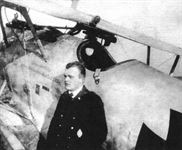 |
J.Herris - Pfalz Aircraft of WWI /Centennial Perspective/ (5) |
| Lt. Carl Kuning in front of his Pfalz D.IIIa of a Marine Feld Jasta (MFJ III?). |
 |
J.Herris - Pfalz Aircraft of WWI /Centennial Perspective/ (5) |
| A Pfalz D.IIIa at Jastaschule with an LVG C.V. |
 |
O.Thetford, P.Gray - German Aircraft of the First World War /Putnam/ |
| Albatros D V fighters taking off on patrol. A solitary Pfalz D III can also be seen in the background. |
 |
A.Jackson - British Civil Aircraft since 1919 vol.3 /Putnam/ |
| Pfalz D.III replica |
 |
В.Кондратьев - Самолеты первой мировой войны |
| Современная летающая реплика "Пфальца" D.III на одном из авиашоу. |
 |
J.Herris - Pfalz Aircraft of WWI /Centennial Perspective/ (5) |
| The Pfalz D.IIIa from Jasta 20 interned after a forced landing at Schoondijke, Zeeland at about 20:30 hours. The German insignia have now been painted over. |
 |
J.Herris - Pfalz Aircraft of WWI /Centennial Perspective/ (5) |
| Rearview of the Pfalz D.IIIa from Jasta 20 now in Dutch markings illustrates the rounded lower wingtips and broad-chord tailplane characteristic of the D.IIIa and the printed camouflage fabric on its flying surfaces. The Dutch government did not buy it from Germany, but took over the undamaged fighter and flew it as PF225 until 1920. |
 |
J.Herris - Pfalz Aircraft of WWI /Centennial Perspective/ (5) |
| Pfalz D.IIIa in Turkish Service. A batch of late production Pfalz D.IIIa fighters, probably 20 aircraft, was built for Turkey. Here is a photograph of one of these aircraft with Turkish insignia, the crescent and star insignia, not the black square used by German aircraft in Turkey. |
 |
J.Herris - Pfalz Aircraft of WWI /Centennial Perspective/ (5) |
| Pfalz D.IIIa 1365/18 is shown being shipped to Palestine for Turkish use. The rudder has been painted white for the Balkenkreuz insignia, and an unbordered Balkenkreuz is on the fuselage. These photos show the last Pfalz D.IIIa series went beyond D.1349/18; probably 20 Pfalz D.IIIa 1350-1369/18 were built for Turkey. This batch of D.IIIa fighters also means that the first Pfalz D.XII production batch did not start with serial D.1350/18; instead it probably started with 1370/18? |
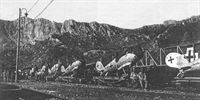 |
J.Herris - Pfalz Aircraft of WWI /Centennial Perspective/ (5) |
| Pfalz D.IIIa fighters at Kara-Pumar on their way to Palestine. An upper wing is mounted on the flat car behind the tail of the D.IIIa on the extreme right. The wing is covered in lozenge fabric with a wide-bordered Balkenkreuz. |
 |
J.Herris - Pfalz Aircraft of WWI /Centennial Perspective/ (5) |
| Pfalz workmen manufacturing Pfalz D.III cabane struts. |
 |
J.Herris - Pfalz Aircraft of WWI /Centennial Perspective/ (5) |
| Pfalz D.III, possibly of Kest 8, standing on its nose after a poor landing. This D.III is in the basic factory finish of overall silver-gray with Maltese crosses; the spiral is a personal marking.The Kests (Kampfeinsitzer Staffeln) were home-defense units stationed behind the lines to intercept bombing raids on German towns. |
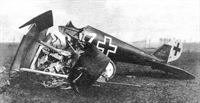 |
J.Herris - Pfalz Aircraft of WWI /Centennial Perspective/ (5) |
| A dark-painted Pfalz D.IIIa, tactical '7' of an unknown unit, has come to grief. |
 |
J.Herris - Pfalz Aircraft of WWI /Centennial Perspective/ (5) |
| Derelict German aircraft after the war. The Pfalz D.III fuselage second from left carries an interesing marking. The Pfalz D.XII next to it wears late camouflage. |
 |
J.Herris - Pfalz Aircraft of WWI /Centennial Perspective/ (5) |
 |
J.Herris - Pfalz Aircraft of WWI /Centennial Perspective/ (5) |
 |
Журнал - Flight за 1918 г. |
| Fig. 1. - Side elevation and plan of the Pfalz body to scale. |
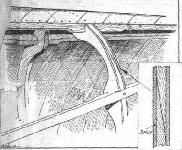 |
Журнал - Flight за 1918 г. |
| Fig. 2. - Sketch showing construction of body former and attachment of longeron. |
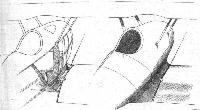 |
Журнал - Flight за 1918 г. |
| Fig. 3. - The wing roots are formed, on the Pfalz, integrally with the body. On the left is shown the construction of these roots, and on the right the final shape. |
 |
Журнал - Flight за 1918 г. |
| Fig. 4. - Perspective view of the Pfalz body, stripped of its ply-wood covering. |
 |
Журнал - Flight за 1918 г. |
| Fig. 5. - <...> showing method of covering with ply-wood the body of the Pfalz. |
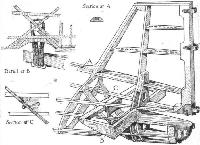 |
Журнал - Flight за 1918 г. |
| Fig. 6. - Sketch showing mounting of the tail plane root on the Pfalz. The plywood covering of the root has been omitted for the sake of clearness. |
 |
Журнал - Flight за 1918 г. |
| Fig. 7. - Some tail plane details of the Pfalz. |
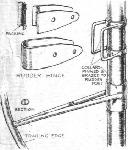 |
Журнал - Flight за 1918 г. |
| Fig. 8. - The rudder of the Pfalz is built up of steel throughout. The sketches show the main features of the detail construction. |
 |
Журнал - Flight за 1918 г. |
| Fig. 9. - Sketches showing safety-belt attachment on the Pfalz |
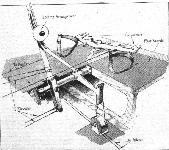 |
Журнал - Flight за 1918 г. |
| Fig. 10. - Perspective drawing of the Pfalz controls. Note the adjustable foot-bar arrangement. |
 |
Журнал - Flight за 1918 г. |
| Fig. 11. - The control handle of the Pfalz biplane. The left-hand handle is rotatable, and operates the throttle via Bowden cable. |
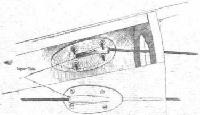 |
Журнал - Flight за 1918 г. |
| Fig. 12. - Guide tubes for the rudder and elevator control cables of the Pfalz biplane. |
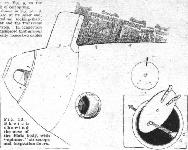 |
Журнал - Flight за 1918 г. |
| Fig. 13. - Sketch showing the nose of the Pfalz body, with "spinner,'' air scoops and inspection doors. |
 |
Журнал - Flight за 1918 г. |
| Fig. 14. - Sectional view of the stream-lining of the axle on the Pfalz biplane. |
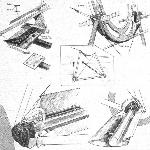 |
Журнал - Flight за 1918 г. |
| Fig. 15. - Details of the Pfalz undercarriage. In the centre a general view of the undercarriage. |
 |
Журнал - Flight за 1918 г. |
| Fig. 16. - Wiring Diagram of the Pfalz Single-Seater. The bracing of the centre-section struts does not run across the top of the body. |
 |
Журнал - Flight за 1918 г. |
| Fig. 17. - Attachment of centre section struts to body on the Pfalz. |
 |
Журнал - Flight за 1918 г. |
| Fig. 18. - Quick-release attachment of lower wing spars to fixed wing roots of the Pfalz single-seater. |
 |
Журнал - Flight за 1918 г. |
| Fig. 19. - General arrangement of the wings of the Pfalz. |
 |
Журнал - Flight за 1918 г. |
| Fig. 20. - Upper and lower wing sections of the Pfalz. Inset sections of the wing spars. |
 |
Журнал - Flight за 1918 г. |
| Fig. 21. - Attachment of centre-section struts to top plane of the Pfalz. On the right the fitting is shown from a different point of view. The inset shows the wiring lug plate, which also serves as a guide for the end of the compression tube. |
 |
Журнал - Flight за 1918 г. |
| Fig. 22. - Details of the attachment of inter-plane struts to lower plane of the Pfalz single-seater. The smaller insets show a section of the inter-plane struts and - in the left-hand corner - the attachment of the wing ribs to the spars. The top flange is shown cut through so as to show the details below. |
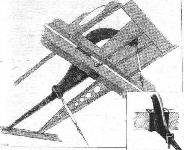 |
Журнал - Flight за 1918 г. |
| Fig. 23. - The aileron crank lever of the Pfalz. |
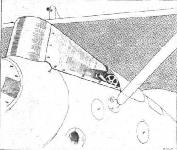 |
Журнал - Flight за 1918 г. |
| Fig. 24. - The machine-guns on the Pfalz single-seater are totally enlosed, with the exception of the muzzle. Note the scoop in the engine housing. |
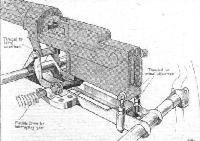 |
Журнал - Flight за 1918 г. |
| Fig. 25. - The mounting of one of the two synchronised Spandau machine-guns which constitute the armament of the Pfalz. |
 |
Журнал - Flight за 1918 г. |
| Fig. 26. - The radiator of the Pfalz is mounted in the top plane, and the cooling is varied by means of a shutter. The details of the locking device which enables the shutter to be left in any desired position are shown in the inset. |
 |
Jane's All The World Aircraft 1919 /Jane's/ |
 |
Jane's All The World Aircraft 1919 /Jane's/ |
 |
Jane's All The World Aircraft 1919 /Jane's/ |
 |
J.Herris - Pfalz Aircraft of WWI /Centennial Perspective/ (5) |
| Factory drawing of cross section of Pfalz D.III forward fuselage showing location of buried guns and other components. |
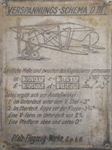 |
J.Herris - Pfalz Aircraft of WWI /Centennial Perspective/ (5) |
| Metal Pfalz D.III rigging diagram. |
 |
Jane's All The World Aircraft 1919 /Jane's/ |
| The D.III Type Pfalz |
 |
W.Green, G.Swanborough - The Complete Book of Fighters |
| The D III which saw service from autumn 1917. |
 |
O.Thetford, P.Gray - German Aircraft of the First World War /Putnam/ |
 |
R.Kosin - The German Fighter since 1915 /Putnam/ |
| Pfalz D.IIIa |
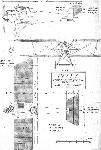 |
Журнал - Flight за 1918 г. |
| THE PFALZ SINGLE-SEATER FIGHTER. - Plan, side and front elevation to scale. |
 |
В.Кондратьев - Самолеты первой мировой войны |
| Pfalz D.III |
 |
J.Herris - Pfalz Aircraft of WWI /Centennial Perspective/ (5) |
| Pfalz D.III |
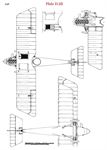 |
J.Herris - Pfalz Aircraft of WWI /Centennial Perspective/ (5) |
| Pfalz D.III |
 |
J.Herris - Pfalz Aircraft of WWI /Centennial Perspective/ (5) |
| Pfalz D.III |
 |
J.Herris - Pfalz Aircraft of WWI /Centennial Perspective/ (5) |
| Pfalz D.IIIa |
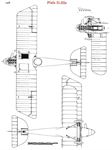 |
J.Herris - Pfalz Aircraft of WWI /Centennial Perspective/ (5) |
| Pfalz D.IIIa |
 |
J.Herris - Pfalz Aircraft of WWI /Centennial Perspective/ (5) |
| Pfalz D.IIIa |
 |
J.Herris - Pfalz Aircraft of WWI /Centennial Perspective/ (5) |
| Pfalz D.III 1370/17 of Vzfw. Hecht, Jasta 10 |
 |
J.Herris - Pfalz Aircraft of WWI /Centennial Perspective/ (5) |
| Pfalz D.III 1395/17 of Lt. Aloys Heldmann, Jasta 10 |
 |
J.Herris - Pfalz Aircraft of WWI /Centennial Perspective/ (5) |
| Pfalz D.III 4011/17 of Lt. Fritz Hohn, Jasta 21 |
 |
J.Herris - Pfalz Aircraft of WWI /Centennial Perspective/ (5) |
| Pfalz D.IIIa 42xx/17, Jasta 4 |
 |
J.Herris - Pfalz Aircraft of WWI /Centennial Perspective/ (5) |
| Pfalz D.IIIa 8033/17 of Offz-Stv Schuschke, Jasta 64w. |
 |
J.Herris - Pfalz Aircraft of WWI /Centennial Perspective/ (5) |
| Pfalz D.IIIa of Vzfw. Max Holtzem, Jasta 16b. |
 |
J.Herris - Pfalz Aircraft of WWI /Centennial Perspective/ (5) |
| Pfalz D.IIIa of Lt. Erich Kaus, Jasta 30. |
 |
J.Herris - Pfalz Aircraft of WWI /Centennial Perspective/ (5) |
| Pfalz D.IIIa, Jasta 37 |